
|
 |

|
 |
Vanashree Rao: I like powerful stories - Shveta Arora e-mail: shwetananoop@gmail.com Pics: Anoop Arora June 11, 2020 Vanashree Rao is a Kuchipudi dancer/teacher, and wife of Guru Jayarama Rao, who has come into her own again through Rasa United, a collaboration between Kuchipudi, Bharatanatyam and Chhau, with Dr. S. Vasudevan bringing the Bharatanatyam and Carnatic music expertise and Kuleshwar Kumar Thakur providing the Chhau expertise and dancers. Over the past few years, the group led by Vanashree Rao, has staged impressive, action packed productions depicting dramatic mythological episodes. Their productions include Dramatic Tales, Abhimanyu Vadh and the latest, Tryambakam, which is centred on Shiva and depicts three aspects of the godhead - aghori, ardhanarishwara and kirat, but it also had other connotations. Three gurus from three dance forms presented the tales, and the choreography and music seamlessly amalgamated all three forms till it became one memorable experience. In an enjoyable and colourful conversation this past winter with Vanashree and Dr. S. Vasudevan, she spoke about her journey in dance and in life, and how they brought her to a point where she realized her creative vision through Rasa United. There is an action packed narrative in every Rasa United production. How do you go about the process of making a grand production with three dance forms? Vanashree Rao: Kuchipudi is a drama tradition, but the dancers, mostly females, usually take up shringara based compositions, almost like in old Telugu movies. Even the male dancers perform very feminine pieces. These days, the youngsters are doing a good job. They stick to a certain format. We should also move on and do something that retains the flavour of Kuchipudi storytelling, the proper grammar in the classical way, but it should be entertaining and powerful. If I keep on doing the same thing without thinking of the impact, it does not work. I wanted to do dramatic stories from mythology. I thought about Bharatanatyam and Chhau because in characterization, there are certain things suitable for Kuchipudi, certain things for Bharatanatyam and certain things for Chhau. For my own reasons, I didn't want to use Kathak or Odissi. In Chhau, they are used to body-oriented work like in Kalaripayattu or the martial arts and they dance to the beats of a drum and a windpipe. That is their tradition. I thought if I give them characters, like in Tripurasur Samhar, it might work. Chhau dancers can easily do headstands and yoga postures - that is what mythology says sadhus did. Shiva is enacted by Vasudevan in Bharatanatyam or by me, and a few of my disciples in Kuchipudi take on various roles. That is the thought and process with which I made seven productions. I still don't know how I managed it! The first step is to write the script. I did not want to use Telugu, Hindi or English. I wanted only Sanskrit. In classical dance, no other language has quite the same impact as Sanskrit. Sanskrit has a power of its own; it lends itself very well to dramatic dancing. You may dance to a Hindi song, but it will lack that power. That is my conviction. Tamil also has that strength, but I do not know Tamil. All the varnams are in Telugu. So I thought Sanskrit was best, because Sanskrit has a weight that lends itself to dance. I learnt Ananda Tandavam Maade in Chennai from Guru Vempati Chinna Satyam. When I wanted to put it in a production, I wanted Vasudevan to do it because I did not want to change what I had learnt. That is not my choreography, and I learnt it directly from Master. I just wanted to put a separate dimension - if tandava is there, then Shiva should be there to add that dimension. That was my second choreography. The third was Jagadoddharana. I changed it totally and added an element of drama to it by adding the story of Kaurava-Pandava conflict and Krishna going to the sabha to ask for 5 villages. Dhritarashtra refuses and Duryodhana tries to capture Krishna. The stories are already there, but you have to choose those that can make the maximum impact. I did not want any shringara rasa or romance. Jayadeva's ashtapadis are all being done by dancers in various forms already. There is nothing dramatic about these compositions. And my theme is dramatic tales. So I thought of Abhimanyu Vadh. I took the various Mahabharatas, did research on Shiva from the Shiva Purana and on an instinct, I stuck to one shloka that relates to what I wanted to do. I went through the whole of Kiratarjuniya by Bharavi and chose just four shlokas. The story of how Arjuna got the pashupatastra as a boon was clear. I took just one line from a book of 500 pages to enunciate the tale. 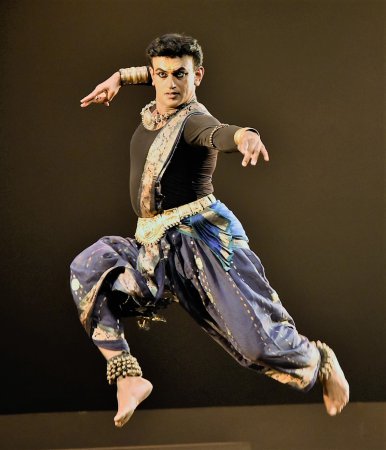 Vasudevan in Abhimanyu Vadh 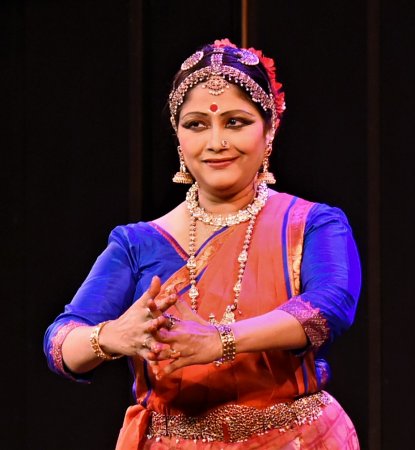 Vanashree Rao Vasudevan: D.V. Prasanna Kumar is a nattuvangam and percussion artiste who gives all the special effects with drums, octopad, keyboards etc. He is the most sought after person for this in the country. Vanashree Rao: He did the entire sequence of Abhimanyu Vadh. He came for one day, readied the scene and went back in the evening. I told him that I want the fight scene to be in three stages - with sword, hand-to-hand and then the climax. We made it in two hours. Vasu, Venkatesh, Keshavan and Prasanna - they say that in my kind of music, they don't take much time, but only if they have total freedom can they do a good job. If you keep on giving instructions, there is a clash of egos. I just give them the script and the scenes and they do the music. In the past 2 years, we have done 14 productions and 76 shows. I don't think anyone has done that many. I take a concept and stick to it. If it's Dramatic Tales, then I add a lot of drama to incidents which are dramatic. The music doesn't let your attention wander for one minute. And I can't take bad dancers. Many people now say, 'We want to dance with your group,' but I don't take dancers on request. I can manage with very few girls - I had four in my group, but Ranjini Nair, one of my disciples, has now gone to Oxford. But if I want to do something, I will do it, even without the girls. The concept should be strong, then the music will be strong and so will the performance. That is my philosophy. I started in 2016 - the first show was on 7 November on the IIC lawns. At the time, I didn't think the shows would be so highly appreciated. But critics Dr. Kothari and Leela Venkataraman have been appreciative of my choreographies. I have a fantastic team; among us is a lot of love, affection and positive energy. Like Prashant Kalia (Chhau dancer, choreographer and model), who did Ardhanarishwara. When I gave him that role of Shiva, I wrote that script keeping him in mind, and told him I want only him to do that. Vasudevan: I believe that for Dramatic Tales and Rasa United, the key is Didi's (Vanashree) optimism and open-mindedness, where there is no guru-shishya role or classroom thinking, purely artistic thinking. Vanashree Rao: Suggestions are welcome. If I don't like it, I will tell them so. Sometimes, these people discuss so much and come to no conclusion that I throw up my hands and say I am the director. For two years, I could not dance, I had actually thought of taking retirement because my business (Kalamkari garments) is doing well, but then something happened and I thought I should. My son has been a very big force in bringing me back to dance. He told me I should think about the younger generation - attract them, and be professional. Vasudevan: I remember, Didi said I must do Shiva, but not to use Om. Vedabrata Rao (Beda, Vanashree's son) said, 'All your items have Om and start with that. It is overdone.' That was indeed a good challenge. It helped us beat our own stereotypes. 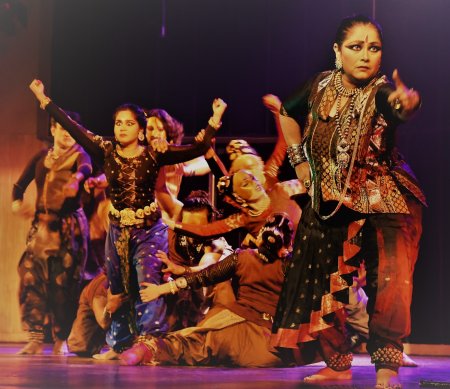 Abhimanyu Vadh  Mahishasur Mardini Vasudevan: Dushasana Vadh was different. Abhimanyu Vadh was a choreographic war going on - a team, a group, soldiers doing warfare and all. But Dushasana Vadh was a fight between two individuals on stage; it was a different theme. Vanashree Rao: Nobody expected Vanashree Rao to do fighting. Vasudevan: Vande Vasudevam was the first time I got involved with Didi and Guru Jayarama Rao. I joined them as a nattuvangam artiste. Vanashree Rao: I learnt Odissi also for nine years. I got married in 1981, and at the time, we had no work. Gurus Raja-Radha Reddy and Guru Swapnasundari were the reigning dancers in the Kuchipudi scene. My husband, the senior-most Kuchipudi artiste in Delhi, never got that publicity. He didn't know a word of Hindi or English, he was a self-taught person, he lived alone, no name or anything, but he has taught many people who went on to become famous. When I started learning, my first guru was Krishna Kumar in Triveni - he told me to learn from Jayarama Rao. When I started learning from him, I asked him, 'Why don't you dance?' I've changed a bit now, but I've always been a very mischievous person at heart. I was always teasing him - he was so traditional that for him, I was a 'fast' girl. He wasn't used to a woman who talked so much... I told him, 'These students of yours, they learn but don't pay?! Then when you give them shows, they say we have learnt from Master Vempati Chinna Satyam!' It then struck him that I could be of help. He said, 'I want to dance, but no one gives me shows on my own.' So I said, 'As long as I'm learning from you, I'll do shows with you.' We started doing small duets. He used to be so conservative - at one point someone said the costume needed to be changed to something smarter, but no, he said we will do what is traditional. Delhi did not have very good musicians for Kuchipudi at the time and I knew nobody. We would dance to such high-pitched singing - how would I know better? Nevertheless, we made a name. When we got married, we had no work. I used to do freelancing jobs, he used to teach a few people, we just about managed somehow. We met famous critic Subbudu maama, and Odissi Guru Mayadhar Raut at a Sangeet Natak Akademi lunch. Subbudu maama asked Mayadhar Raut if a Kuchipudi dancer can learn Odissi. He said yes, why not. I said, 'Guruji, I will learn if you teach me yourself.' My husband said, 'Go, learn, we anyway have no work.' And that is how I started learning Odissi. I started practicing very seriously. I had a language issue - in those days, I didn't understand the language, and though I wanted to give the bhava, it wouldn't come; something was blocking me. The ashtapadis were in Sanskrit, which I knew, so it was easy to understand those. After a year and a half, I realized I was doing the same things with the group. I told Guruji, 'I don't think you are actually teaching me the intricacies of abhinaya, which I want to learn. I will learn dedicatedly but I can't leave home and hearth and do Odissi all the time like this. What I am learning is very superficial.' He asked me to come next day at 8am. That's when he kept my class from then on. We used to live in a Hauz Khas garage at that time. I used to come by bus and Rama Rao-ji would pick me up later on a scooter. I can't forget that one lesson. I have learnt from so many gurus - I learnt from Vempati master for three years, though that was much later and he was fond of me. I have later learnt abhinaya from Nataraja Ramakrishna, and of course from Rama Rao-ji and Krishna Kumar before that. But when Mayadhar Raut showed me 'Sakhi he kesi madanamudaram', those two lines that he explained taught me abhinaya for life. It just opened something up inside me, and I finally understood what he was trying to tell me; I could feel it. After one year he told me to do a show but not to tell anyone he had told me to. I applied to Sahitya Kala Parishad for a competition in which they used to award the best dancer. I presented a full Odissi program for the first time in Triveni. Critic Leela Venkataraman was there. She wrote that she had never seen sakhi abhinaya of that sort in her whole life, such impassioned abhinaya of 'Sakhi he kesi madanamudaram'. Overnight, I became a star in Odissi - everybody was calling me to do programs in Odissi. I was adjudged the best dancer in the Sahitya Kala Parishad competition. Leelaji said, 'Maybe because you are Bengali, Odissi is coming to you so easily.' Then Subbudu maama said, 'When she does Kuchipudi, it does not seem like she does Odissi, and when she does Odissi, it does not seem like she does Kuchipudi.' I did many programs, and Lalit Mansingh at ICCR also invited me. Then Guru Jayarama Rao and I started a joint Odissi and Kuchipudi school, though we didn't have the support of many musicians. Then the problem started because Guru Mayadhar Raut was put in a spot over teaching me. I thought I have Kuchipudi anyway. Rama Rao-ji said, 'Why don't you teach, you have learnt for nine years.' I said, 'If I move away from Kuchipudi now and to Odissi, what will you do?' The whole purpose of getting married was to do Kuchipudi together and propagate it. So I told myself, it's fine, I have learnt it and I have the abhinaya process in me, which I still use. My abhinaya is not very loud, it's very subtle. I learnt that from Odissi. The Odissi chapter ended there and I started concentrating on Kuchipudi, which became easier for me in terms of abhinaya, regardless of the language. The moment I understood the theme, the expressions just came; the bhava was instinctive rather than taught. Then I started doing Kuchipudi programs; the Sangeet Natak Akademi gave me a grant and I learnt 4-5 padams from Nataraja Ramakrishna. When I do his 'Evade Vaadu', Dr. Sunil Kothari says, 'He's blessing you from his grave, you're doing it exactly like he used to.' I did a lot of things to get to a point where I could really appreciate the art and the literature. I was happy doing duets, but it occurred to me that I should do something new; it should reach out to new people. And I like powerful stories, I don't like shringara always. At my age, I feel, dancers should not go on stage as the heroine. They should do roles that are suitable for them. Unfortunately, there are not many students of Kuchipudi in Delhi. These days, many modern students have no angashuddhi. There may be many good ones, but what I have seen is that the standards are not what I have learnt, they have become diluted. The movements are very difficult, but they have been diluted, made easy, and now it looks light and filmi. Vasudevan: The Ananda Tandavam Maade choreographed by Masterji requires a lot of energy and stamina, both mental and physical preparation; it's a very heavy duty choreography. Each item of his is like that, which is great. They have learnt directly from Masterji. Vanashree Rao: But I can't do those pieces now because people have made mashups of those pieces. A lot has happened in life, and I had come to a point where I wanted to do something, and I could not have done it without my Rasa United collaborators. Vasudevan: I have been associated with Didi for more than a decade now. I joined them as a young student, dancer and nattuvangam artiste. I used to travel a lot with SPIC MACAY. Once, during a tour, someone in the audience asked the difference between Kuchipudi and Bharatanatyam. She told me, 'Come here and dance,' took off her ghungroos and gave them to me. It was a big hearted gesture, something that keeps me motivated. Second is there is an original thought and vision, even when she speaks. Though these are familiar mythological stories, each individual has a distinctive approach. But one formula of Didi I like is that in 3 minutes, she can present a grand story. Vanashree Rao: In Abhimanyu Vadh that we performed at Purana Qila, everything from Subhadra's pregnancy to Abhimanyu breaking and entering the chakravyuha was shown in 3 minutes. Why drag it out? Solo is to show your artistry. There you are doing sancharis etc., but in a production, you need to be crisp and taut. Vasudevan: The audience is also different - the group audience is not for solo and the solo audience is not for group. Vanashree Rao: Now that I have shifted from solo to duet to group, I feel nobody should criticize the others, because all are essential. What we show in solo is necessary. At the same time, group choreography is not easy. You have to consider many points that are not considerations in solo. Vasudevan: The whole point is getting the right dancers for the right characters. It's like a huge engineering project. 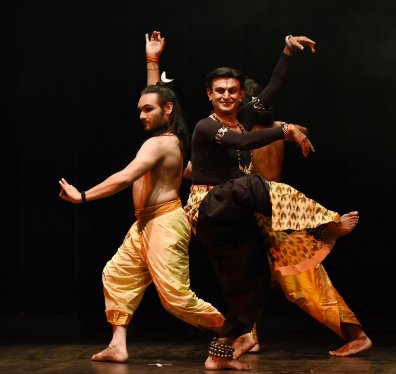 Vasudevan in the lead along with Chhau dancers in Tryambakam 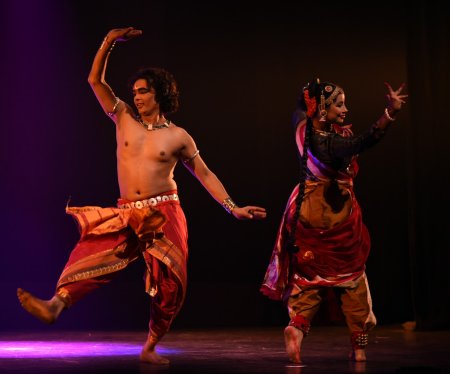 Kuleshwar Kumar Thakur (Chhau) with Ayana Mukherjee (Kuchipudi) in Abhimanyu Vadh Vasudevan: Prashant Kalia, who has done Shiva this time in Tryambakam is very good. It's difficult for even a Kuchipudi dancer to notate and grasp those jathi patterns. He did it in just two sittings. He internalizes the whole jathi. He's a Punjabi, has no background of Bharatanatyam or Kuchipudi, but he's brilliant; he's a natural, genuine artist true to his art. He also choreographs for films. Salsa, contemporary, Zumba - we have seen most of his other facets also. Vanashree Rao: And this is for the first time that he got a name. Otherwise, they are usually placed in the back. I tell Kuleshwar, 'You have a name now, an identity, don't run off and stand behind a pole in other programs; I feel bad. I feel that even if it means a little less money...you will do the same jumps, people will say the same things, what will you get out of that?' Vasudevan: It's a huge effort to maintain one's vision. That's what Didi has always given to everyone in the team. Once you have the storyline and concept, you have three diverse forms, and Chhau is totally different from Kuchipudi and Bharatanatyam. How do you go about the process with the music, rhythm and choreography, gelling the three forms? In Tryambakam, it was amazing to see how they were twisting their feet before every leg lift, which is a very typically Chhau move, and Dr. Vasudevan was jumping as high as a Chhau dancer. Vasudevan: I think what we understand about Bharatanatyam, Kathak or any dance form is through the schools. But when we talk of shastras, they don't bind us to a school. The school is by the teacher. But the shastras are older and have been created by generations of thinkers and creators who have practised more than we do today. Technically speaking, if we take the Abhinaya Darpana, we don't take up bhramaris, akasha bhramari. Chhau does it, Kuchipudi does it, Bharatanatyam did it, but not all schools of it. It's all about the versions then. If I jump high, it is akashachari for me. If I take a twirl or a straight jump, it is like an ekapadabhramari. Many dancers were not directly taught the prayogas or viniyogas. Being in the art form teaches you more. I have read and heard in Rukmini Devi's interviews, she says technique is to learn and forget. You can't dance with the technique in mind; you will not get into the application. Technique is for your body to practice and to tame your mind - muscle memory etc. But the actual dance form is the dance free from nomenclatures of Bharatanatyam. With the compositions we choose, like in solos, the outline of a school appears - we bind ourselves to the norms we have gained from our gurus. But in a production, what I don't do in my solos, I do here, though it is still Bharatanatyam. 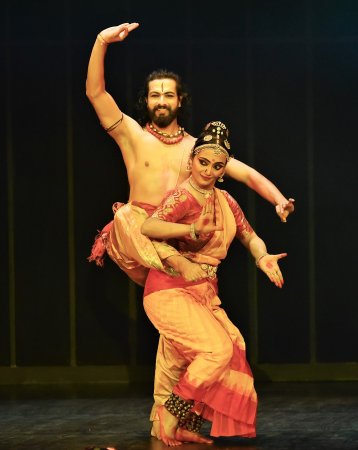 Prashant Kalia and Moutushi Majumder in Tryambakam Vanashree Rao: In a solo, he has to follow a margam. In group choreography, he can give his imagination free rein and use the movements of his body. But he cannot dance outside his Bharatanatyam medium and he has not done it. And that movement of leg you mentioned in Shiva-Parvati... it is there in Kuchipudi and in Chhau too. But they are doing it in their own ways. When I choreographed it, I told Moutushi Majumder, my disciple, to do it in Kuchipudi and I told Prashant to do this in his own way in Chhau. Moutushi and Prashant hardly practised together. She is a researcher and she travels a lot. He had hired a studio to practice on his own. Moutushi practiced with me whenever she got the time. But they did a good job. It was for the first time that I gave Moutushi a major role. Vasudevan: They are both good looking and fit the Ardhanari concept. One is extremely energetic, and the other is extremely tender. Vanashree Rao: These concepts and ideas I didn't think about before, when I was doing duets. I used to think about compositions, but somehow I had a block, I was not able to go outside my field. Vasudevan: Till she got cut off from conventional Kuchipudi, she was not able to do it. It had its natural birth in 2016. It's not the school but the individual thought. Shastras never say no to any kind of innovation. Vanashree Rao: Maybe that was the right time. I went through a lot of depression and illness; then I thought I should get up and do something. My nature is such that when somebody or circumstances push me down, I want to defy it. Since school - getting admission to Delhi's Lady Shri Ram College, nobody talking to me in LSR as I spoke little English - I don't get defeated by people and their opinions. Even when I came into dance, everybody made fun of me. I never bothered, I just did my work. Maybe it is because of my family background: all of us are highly educated, my brothers are scientists, and they respect me for what I have done in a field about which I did not know anything. I did not have the financial resources to do more... but if I had, perhaps I would not have been interested! Please tell us about designing the rhythm for the fusion of dance patterns in Tryambakam, particularly Chhau. Vasudevan: Tryambakam was done keeping one singular godhead Shiva in vision, which made all the dancers in the team think unitedly, plus familiarity with the godhead gave us one easy way to move ahead and understand the production. The major music section and rhythm section was contributed by S. Venkateshwaran (Satish Venkatesh). He beautifully conceived the whole flow of thought into the first four layers, majorly the first three layers, of the categories of Shiva, and aghori was very authentically conceived keeping Chhau in mind, but not totally designing it for Chhau. That rhythm is for any design form. Shveta Arora is a blogger based in Delhi. She writes about cultural events in the capital. Post your comments Unless you wish to remain anonymous, please provide your name and email id when you use the Anonymous profile in the blog to post a comment. All appropriate comments posted with name and email id in the blog will also be featured in the site. |